By Jackie Damrau, Editor
Books Reviewed in This Issue:
Usability Testing Essentials: Ready, Set. . .Test!, 2nd ed.
by Carol M. Barnum
Diversity’s Promise for Higher Education: Making It Work, 3rd ed.
by Daryl G. Smith
100 Things Every Designer Needs to Know About People, 2nd ed.
by Susan M. Weinschenk
Hope Matters: Why Changing the Way We Think is Critical to Solving the Environmental Crisis
by Elin Kelsey
Simplicity: The Appeal of Minimalism in Graphic Design
by Wang Shaoqiang, ed.
Too Much Information: Understanding What You Don’t Want to Know
by Cass R. Sunstein
A Guide to EU Environmental Law
by Josephine van Zeben and Arden Rowell
Company of One: Why Staying Small is the Next Big Thing for Business
by Paul Jarvis
Office Optional: How to Build a Connected Culture with Virtual Teams
by Larry English
Heroic Technical Writing: Making a Difference in the Workplace and Your Life
by Bart Leahy
WordPress: The Missing Manual® – The Book that Should Be in the Box®, 3rd ed.
by Matthew MacDonald
Languages of the World: An Introduction, 3rd ed.
by Asya Pereltsvaig
Drawing Investigations: Graphic Relationships with Science, Culture, and Environment
by Sarah Casey and Gerry Davies
In the Know: Debunking 35 Myths About Human Intelligence
by Russell T. Warne
Persuasion: Convincing Others When Facts Don’t Seem to Matter
by Lee Hartley Carter
How to Keep Your Doctorate on Track: Insights from Students’ and Supervisors’ Experiences
by Keith Townsend, Mark N.K. Saunders, Rebecca Loudoun, and Emily A. Morrison, eds.
WordPress for Dummies, 9th ed.
by Lisa Sabin-Wilson
Bookishness: Loving Books in a Digital Age
by Jessica Pressman
Creating Effective Visualizations for Technical Communication <Images, Videos, Interactive Content>
by Marc Achtelig
Hyper-Learning: How to Adapt to the Speed of Change
by Edward D. Hess
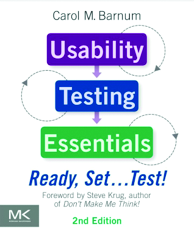 Usability Testing Essentials: Ready, Set. . .Test!
Usability Testing Essentials: Ready, Set. . .Test!
Carol M. Barnum. 2021. 2nd ed. Morgan Kaufmann.
[ISBN 978-0-12-816942-1. 448 pages, including index. US$46.99 (digital).]
The second edition of Carol Barnum’s Usability Testing Essentials: Ready,
Set. . .Test! proves the long-standing value of this volume to the technical communication field by providing a no-nonsense introduction to usability testing that is useful to both novices and experienced professionals. As mentioned in the Acknowledgments, the core of the book is unchanged and discusses “conducting usability testing, analyzing the results, and reporting the findings” (p. xix). Barnum has largely updated tools and trends that have emerged since her original published book in 2010.
These updates include discussions of remote usability testing (pp. 86–88), a new generation of usability tools that have come to market (pp. 91–94), statistics about who is currently online (p. 108–120), and more. The book continues with a rigorous discussion of the various long-standing methods available to user experience (UX) researchers, including building a UX toolkit (Chapter 2), understanding the psychology of users (Chapter 4), and, of course, planning, preparing, conducting, analyzing, and reporting on usability tests (Chapters 5–10).
Usability Testing Essentials is divided into two parts. Chapters 1–4 set the stage for usability by discussing important contextual information. This includes an explanation of the importance of focusing on users, not products (p. 10), definitions for UX and user-centered design (UCD) (pp. 16–18), heuristic evaluation (pp. 46–50), acquiring testing equipment (pp. 70–72), and developing user personas (pp. 120–124). Chapters 5–10 then discuss the process of usability testing in its entirety, including scheduling the initial planning meeting (p. 136), creating the initial test plan (p. 187), recruiting participants (p. 198), creating a testing team (p. 205), choosing feedback methods (p. 237), setting up tests (p. 250), moderating tests (p. 250), collating findings (p. 296), presenting qualitative data (p. 298), and preparing a formal report (p. 328). Chapter 10 focuses on working with international users.
Barnum also includes testing examples, case studies, sample documents, and deliverables garnered from her long history of working in the field. While reading through her book, I didn’t find a single element of usability testing that wasn’t thoroughly explained, illustrated, and exemplified through concrete, real-world cases. After reading this new edition, the reader is privy to an incredibly valuable resource: the inner workings of one of the top minds today in usability research.
Readers will find in this book a complete workflow for becoming competent usability researchers. Though the book doesn’t cover every possible nuance of usability testing—no one volume could accomplish that—Usability Testing Essentials is perhaps one of the most complete books on usability testing available. More importantly, it is written where even a complete novice can understand, but it also contains a wealth of wisdom that seasoned professionals will find useful as a reference guide to the most difficult art and science that is usability testing.
Guiseppe Getto
Guiseppe Getto is a faculty member at East Carolina University. He is also President and Co-Founder of Content Garden, Inc., a digital marketing and UX consulting firm.
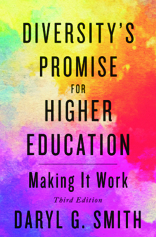 Diversity’s Promise for Higher Education: Making It Work, 3rd ed.
Diversity’s Promise for Higher Education: Making It Work, 3rd ed.
Daryl G. Smith. 2020. Johns Hopkins University Press. [ISBN 978-1-4214-3839-9, 376 pages, including index. US$32.95 (softcover).]
In the third edition of Diversity’s Promise for Higher Education: Making it Work, Daryl G. Smith sums up years of scholarship and experience. Her essential claim is that diversity is not optional but a moral and practical imperative. By meeting this challenge, institutions of higher education can fulfill their mission statements and achieve excellence.
Even those outside of academia may find the book relevant. Smith examines the cultures of institutions and organizations, synthesizing scholarship from multiple academic disciplines and the business world. Anyone with an interest in how an organization can keep an eye on the zeitgeist—and ride the waves of change rather than be overtaken by them—might find this book useful.
That said, this book is not exactly a “how-to.” It’s a book of scholarship, one that—especially in the early sections, when Smith is laying the groundwork for her argument—draws on numerous other scholars (there are 300 pages of body text and 62 pages of references). This doesn’t mean that the prose is dense or dry; it’s smooth, accessible, and surprisingly absorbing.
Diversity’s Promise for Higher Education is broken down into four main sections. In the first, Smith presents the global backdrop against which efforts to achieve diversity are taking place—a world of immigration and changing demographics, of structural inequality too often based on identity (identity as a concept is explored thoroughly). Achieving fairness and equity, according to Smith, has a pragmatic advantage; many scholars “make a direct link between diversity and the health and well-being of democracy.” (p. 8).
The second section argues that universities should treat diversity like they treated technology. That is, just as keeping pace with technology was an absolute imperative, keeping pace with shifts in demographics and culture should be imperative, as vital to institutions’ missions.
The third section suggests that those in higher education will have to “interrupt the usual” to make meaningful changes. One chapter examines faculty hiring practices. Another proposes that actively fostering intergroup dialogues will deter conflict and engender creative thinking and learning.
Finally, the last section sums up the book’s argument thus far, offers a set of recommendations, and posits that although this time of great global flux is challenging it is also an opportunity that universities dare not miss.
Again, if you’re looking for a straightforward “how-to” book with a bulleted list of steps at the end, Diversity’s Promise for Higher Education may not be for you. Though much is written about implementing diversity, there is a level of abstraction that might be disconcerting to some. If you’re looking for a solid background on the issue of diversity, though, and ideas about how and why diversity policies might be implemented at your organization, read this book.
Scott Black
Scott Black has worked as a textbook production editor and taught writing to engineering students.
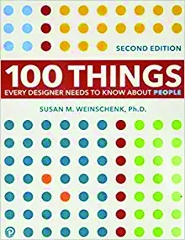 100 Things Every Designer Needs to Know About People, 2nd ed.
100 Things Every Designer Needs to Know About People, 2nd ed.
Susan M. Weinschenk. 2020. Peachpit Press. [ISBN 978-0-13-674691-1. 256 pages, including index. US$29.99. (softcover).]
Every once in a while, a book comes along that is so well-written, researched, and designed that I just can’t put it down. That’s how good 100 Things Every Designer Needs to Know About People is! What makes it so good is that it’s broken down into short segments of a page or two that cover how people read, see, feel, remember, think, and focus their attention, among other interesting topics. Each segment has a “takeaways” section that neatly sums up the contents and emphasizes the relationship to design. In effect, the book’s layout and design mimic the way in which humans process information—very clever indeed.
Susan Weinschenk, who holds a PhD in Psychology and an Adjunct Professorship at the University of Wisconsin, uses her passion for research to educate designers about the psychological and physiological factors that affect our perceptions, motivations, and decision making. The book reminds me of the big book series on psychology, sociology, and philosophy, where theories and movements are clearly presented in small chunks of information, something that Weinschenk advises in her section on attention theory.
The first half of the book is focused mainly on visual communication and design, whereas the latter half delves rather deeply into the psychology of emotion and motivation. This content arrangement makes it easy for designers to quickly pick out the most salient parts of the book. However, I recommend reading it in its entirety for anyone who wants to create user-friendly print and online documents or websites.
In fact, 100 Things Every Designer Needs to Know About People could easily be indexed under psychology or physiology as well as design or user experience as the scope of her research is impressive. She draws upon the areas of cognitive psychology, eye tracking, and visual communication to explore with the reader how the brain works, what our motivations are when viewing objects, and how we make mistakes. Her “takeaway” tips alone represent a potent set of crib notes on how to take advantage of, or even manipulate, our imperfect biological/psychological makeup.
When I’m asked by students or colleagues in education and industry what’s the one book I could suggest to help them with their efforts to produce effective visual media, I would, without hesitation, recommend this book. I’d put a copy of 100 Things Every Designer Needs to Know About People in their hands with the complete confidence that it will, in a most enjoyable and approachable manner, open a larger understanding of how to appeal to their very human audience.
Lynne Cooke
Lynne Cooke is a Clinical Assistant Professor at Arizona State University, where she teaches courses on usability, digital media, and portfolio development. She is also a member of the Arizona Chapter of STC and the Internship Coordinator at ASU.
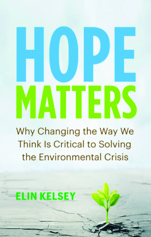 Hope Matters: Why Changing the Way We Think is Critical to Solving the Environmental Crisis
Hope Matters: Why Changing the Way We Think is Critical to Solving the Environmental Crisis
Elin Kelsey. 2020. Greystone Books. [ISBN 978-1-77164-777-9. 230 pages, including index. US$22.95 (softcover).]
Crisis communication is difficult even for small, local problems. When problems extend to the whole world, as in the global environmental crisis, the challenge is daunting. How can we motivate people to act when problems seem insurmountable? In Hope Matters: Why Changing the Way We Think is Critical to Solving the Environmental Crisis, Elin Kelsey provides the answer: If our goal is to motivate action, we must give reasons to hope, without trivializing the problem. She defines hope as optimism based on the possibility of agency and action, not wishful thinking. This is the difference between investing your savings and buying lottery tickets. Focusing relentlessly on negative stories to convince audiences the problem is real creates helplessness and inaction rather than the desired hopeful willingness to act.
Large problems overwhelm us and motivate inaction. Breaking them into smaller problems that are more easily solved makes them feel manageable. Each successful act encourages us to tackle more or larger challenges, as our sense of accomplishment promotes engagement and continuing action. Real-time feedback such as electricity meters and full recycling bins make progress tangible. Reminding people of their agency is essential when the situation seems grimmest; our audience must not move from “I feel hopeless” to “the situation is hopeless.” Forgiving ourselves when we fail or despair can restore courage and liberate us from demotivational fear-based narratives. We understand our reality by creating explanatory stories, so we must create more optimistic stories. After all, we’re not starting at zero: we’ve already accomplished much and can do more. Kelsey provides many success stories and links to collections, such as the Solution Stories Tracker (https://storytracker.solutionsjournalism.org/). The Earth Optimism Summit (https://en.wikipedia.org/wiki/Earth_Optimism) offers another path to success.
Greta Thunberg taught us that building community builds resilience because it creates a sense of support and collective action. Social media have therefore become an increasingly crucial communication medium, particularly for the young. As we learned from Covid-19, the words of our social groups can be more persuasive than the words of experts. Community teaches us hope, and hope and despair are both contagious. Which would you rather spread?
Kelsey presents a concise and powerful evidence-based argument for spreading hope based on a consideration of the psychological, social, philosophical, and spiritual factors that motivate us. Although she focuses on the environmental crisis, her message is applicable to other communication challenges. For example, technical communicators have traditionally neglected the emotional responses that determine how people act. Language choice is also important: the binary either/or (succeed/fail) is less effective than both/and: bad and good both exist, and recognizing the bad can motivate us to act, while recognizing the good leads to hope. It’s time we paid more attention to these factors.
Geoff Hart
Geoff Hart is an STC Fellow with more than 30 years of writing, editing, translation, and information design experience. He’s the author of two popular books, Effective Onscreen Editing and Writing for Science Journals.
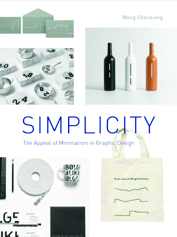 Simplicity: The Appeal of Minimalism in Graphic Design
Simplicity: The Appeal of Minimalism in Graphic Design
Wang Shaoqiang, ed. 2020. Promopress. [ISBN 978-84-17412-71-5. 240 pages, including index. US$45.00 (softcover).]
Simplicity: The Appeal of Minimalism in Graphic Design showcases examples of minimalist work from over 100 worldwide designers. The book is more an exhibition of successful design than a “how-to” manual. Each page shows an example of good design without ever going into detail as to what makes it an effective concept. Drawing from the themes often found within the covers, the book uses minimalism in its own form. It plays with examples of design work to produce a cover that balances appropriate amounts of negative space and pictures. The book’s color palette mimics many of the design palettes found within it: that of neutral background work and a strong navy color for the main wording. This palette is extended throughout the book itself, as neutrals are used in the background, with navy blue pages added as transition pages between the sections.
The Preface begins with a Dieter Rams quote, “Good design is as little design as possible” (p. 5) that covers three pages: one written in English, one in Spanish, and one in French. It is typed in blue ink against a white background and sets the tone for the whole book. Following a blue title page and a blue contents page, this typeface adds to the cosmopolitan, cutting edge vibe that the book portrays. This is juxtaposed against the title page wording, all lower case, “simplicity, the charm of minimalism.” These words are a change, in font and wording, from the actual cover title and lend a feeling of warmth to the worldly nature already attained by the style formatting. The preface asserts that “simplicity has always played a key role in good design” (p. 5), that it creates consistency, is sustainable, and is timeless. “Success. . .is when an idea has found its perfect form” (p. 5). The book is a showcase of such success.
The main body of Simplicity begins with the Pictograph section, which shows designs that center around a picture or a symbol as the main design component. As an example, on page 30, the design for “Meg’s Tailoring” is centered around a button pictograph.
The next section, Number, involves designs centered around numbers, such as the 2902 Gallery on page 96, whose design is centered on the gallery’s unique opening date of 29 February 2008.
The last section, Letter, showcases designs that work with new and innovative use of font. Page 134 displays United Solar Energy’s unique use of the letter E.
Rounding out the book is the Index, written in blue ink against a white ground, which gives background information for the designers and design firms celebrated within the book.
Overall, Simplicity is an incredibly beautiful book and, while I would have preferred detail about what made each example successful as minimalist design, I enjoyed this book. I enjoyed it as much for the way that it expressed minimalist artistic design as I did for the examples found within it of successful minimalist design.
Adrian Shrider
Adrian Shrider is a graduate student at the University of Alabama in Huntsville, Alabama. She has a BA in English and is currently working on her Technical Communication Certificate.
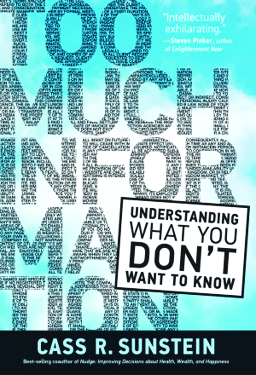 Too Much Information: Understanding What You Don’t Want to Know
Too Much Information: Understanding What You Don’t Want to Know
Cass R. Sunstein. 2020. The MIT Press. [ISBN 978-0-262-04416-5. 252 pages, including index. US$27.95 (hardcover).]
How do policymakers decide what information institutions are required to release to the public? The answer seems simple: when the “information would significantly improve people’s lives”
(p. 1). However, within that simple answer lie difficult questions. How do you measure what is significant? What does improving someone’s life really mean? Can information damage a person’s well-being instead?
In Too Much Information: Understanding What You Don’t Want to Know, Cass Sunstein, former Administrator of the Office of Information and Regulatory Affairs, explores the world of information disclosure and examines how institutions try to answer these questions. As agencies decide what information to disclose, they try to predict the benefits of the information and measure people’s desire for it. One way to value benefits is by monetizing them. When dealing with health information, for example, regulators have established the value of a statistical human life to be about US$9 million. If they can determine the value of the benefits by estimating lives saved, institutions can perform a cost-benefit analysis to find out if the health information is worth disclosing. Another metric Sunstein returns to often is a consumer’s willingness to pay for information. This measurement helps institutions understand what information people want to know and how much they desire it.
Information disclosure is part of our everyday lives, which Sunstein makes clear by providing accessible examples. One of the most memorable is his description of his successful project to require calorie counts on restaurant food, including popcorn at movie theaters. While he thought this was a victory for information disclosure, a friend accused him of ruining popcorn. Throughout the book, Sunstein uses the idea of “ruining the popcorn” to mean information that may be useful to know but unpleasant to hear.
Once information is disseminated, though, its journey isn’t over; people still need to receive it. Sunstein devotes a chapter to the psychology of receiving information. People have a “limited mental bandwidth” (p. 162) with which to process information. We also don’t like bad news and tend to focus on the present. These psychological factors affect how information should be presented. As a technical communicator, I appreciate Sunstein’s advice to keep essential information limited, simple, and salient.
Besides analyzing the disclosure of information from institutions to the public, Sunstein discusses other directions in which information flows. His chapter about the information institutions require from people is especially interesting. He uses the term “sludge” for those mandatory activities (like information-gathering paperwork) that slow down actions like registering to vote, applying for financial aid for college, and canceling magazine subscriptions. While he concedes that some sludge is necessary for privacy and security, one of Sunstein’s calls to action is for institutions to analyze and reduce their information-gathering burden on the public. When dealing with information, whether we’re providing it or receiving it, Sunstein concludes that sometimes less is more.
Elizabeth Hardin
Elizabeth Hardin is an STC member and a lecturer in the English department at the University of Alabama in Huntsville, where she teaches technical and business writing. She has a master’s degree in English and a bachelor’s in Computer Science.
 A Guide to EU Environmental Law
A Guide to EU Environmental Law
Josephine van Zeben and Arden Rowell. 2021. University of California Press. [ISBN 978-0-520-29522-3. 280 pages, including index. US$29.95 (softcover).]
For a topic as complicated as environmental law, Josephine van Zeben and Arden Rowell’s A Guide to EU Environmental Law is an unexpected, easy, informative read. I was struck with the remarkably clear, organized writing and my actual comprehension of the subject matter despite my not having a law background. Since environmental problems affect everyone, addressing audiences other than law students and lawyers was one author-stated goal, which they met with perfection.
The book’s aims are clearly outlined in the preface and flawlessly carried out in subsequent chapters. The book is thoughtfully organized to first provide an “overview of key legal actors, types of law, and regulatory tools that the EU (or the United States) uses to address environmental problems” (p. xiv). This initial information, which might otherwise be dry or difficult to comprehend for non-legal audiences, was quite informative. Tables, spotlight boxes that highlight and explain supplemental or complex concepts, chapter summaries, takeaway bullets, list of key terms and definitions, and thought-provoking discussion questions all aid in understanding chapter material. This background information is crucial to understand the second half of the book, which addresses “specific environmental issues that environmental law regulates: pollution, ecosystem management, and climate change.” (p. xiv).
What surprised me most about these chapters was that I learned more about the complexity of these issues and why we need laws to address them than I have understood over the last decade. For instance, climate change has been in the mainstream news since the 1970s; however, there has been little direct or effective action taken to mitigate the issues leading to and resulting from climate change. Reasons for this inaction are spelled out directly with no extraneous text that takes readers off course or drowns them in a sea of complication. To explain three main reasons for causes and effects of climate change and why regulation is necessary in three paragraphs takes technical writing expertise that is noticeable and appreciated. This is not to say the text is short-sighted or incomplete; on the contrary, concepts are scaffolded to show how one concept and conversation leads to other concepts and conversations and so forth. And once again, chapter supplements aid in the process of providing this information in comprehensible packages. Helpful and interesting appendixes with timelines of EU environmental law, EU membership, additional resources, and a glossary are also included.
Since environmental problems are everyone’s problems, as stated in the beginning, van Zeben and Rowell have provided an accessible interdisciplinary resource that helps readers to understand three major environmental issues and the laws intended to regulate their causes and effects. There is even a companion book on environmental law in the United States should readers want to compare. With or without a background in law, readers can quickly and easily engage with the book content, which in turn can promote meaningful conversations that hopefully will lead to straightforward solutions soon.
Diane Martinez
Diane Martinez is an associate professor of English at Western Carolina University, where she teaches technical and professional writing. She previously worked as a technical writer in engineering, an online writing instructor, and an online writing center specialist. She has been with STC since 2005.
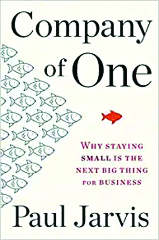 Company of One: Why Staying Small is the Next Big Thing for Business
Company of One: Why Staying Small is the Next Big Thing for Business
Paul Jarvis. 2019. Houghton Mifflin Harcourt. [ISBN 978-1-328-97235-4. 250 pages, including index. US$26.00 (hardcover).]
Paul Jarvis left a successful career as an online designer and consultant for major corporations for a more fulfilling solo entrepreneur role. He shares how small or solo business owners can not only survive but thrive in the marketplace and achieve an improved quality of life by leveraging small businesses’ strengths and following the strategy he outlines in his book, Company of One: Why Staying Small is the Next Big Thing for Business. Although the book is not written for the technical communication field, it’s relevant as many of us work as solo or small business owners or in companies where we are a department of one.
Jarvis reinforces the topics with examples of entrepreneurs who successfully illustrate the book’s strategy and cautionary tales of those who do not. It’s interesting to note that several companies cited in the examples are worth millions of dollars. “Small” in this book refers to a business mindset, not profitability. Each chapter ends with a helpful section, “Begin to Think About,” that asks readers to consider the chapter’s topics as they relate to their own business and personal life.
The main point in Company of One challenges traditional advice that small businesses must grow in complexity to compete. Instead, Jarvis asserts that business owners should “…determine which areas of their business need to scale and when it makes sense to do so” (p. 68). Business owners should base their growth strategy on actual profits and not projections.
While some information may not be new to experienced business owners, Jarvis provides practical advice and insights for starting and managing a successful small business. The book’s sections on delivering superior customer service and building strong customer relationships contain valuable information. Jarvis stresses that small businesses have an advantage over their larger competitors as they likely have a greater understanding of customer needs. Business owners can define their company, distinguish themselves from their competition, and build their reputation as an authority on a topic by teaching and freely sharing their ideas and nonproprietary information. While Jarvis admits that his proposal may sound controversial, he clarifies it by making a distinction between sharing general ideas and their execution. He uses an example from his own life. Jarvis shares ideas regarding this book’s topic freely. However, the execution of his idea (his book) is copyrighted.
Jarvis also advises that it’s important for business owners to build trust and a personal relationship with potential customers before they try to sell them a product or service. People are more willing to listen to someone they know and trust.
In the final chapter, he summarizes the book’s information by drawing upon his own business story to cover the steps for starting a company of one.
Ann Marie Queeney
Ann Marie Queeney is an STC senior member with more than 20 years’ technical communication experience, primarily in the medical device industry. Her STC experience includes serving as a Special Interest Group leader, 2020-2022 Board member, and current CAC (Communities Affairs Committee) Chair. Ann Marie is the owner of A.M. Queeney, LLC.
 Office Optional: How to Build a Connected Culture with Virtual Teams
Office Optional: How to Build a Connected Culture with Virtual Teams
Larry English. 2020. Centric Consulting. [ISBN 978-1-7350567-2-2. 214 pages. US$16 (softcover).]
Larry English has a great story to tell. His story, in part, is about how he is a co-founder and now president of Centric Consulting, a company with a focus on building an office optional approach and a mission of creating a culture of happiness for their employees and clients. Centric is now a 1,000-plus person company with offices in 12 U.S. locations and India.
Larry’s story is also about how before founding Centric, he worked in a traditional office instead of his home, putting in long hours. Feeling burned-out at the age of 25, he quit his office job and backpacked around the world with his newlywed wife. He returned home and co-founded—with like-minded friends—the office optional company of Centric. He now lives in Columbus, Ohio.
In Office Optional: How to Build a Connected Culture with Virtual Teams, English explains how companies can struggle with creating an office optional environment with an effective culture. He taps into his more than 20 years of experience developing a company where people work remotely in a culture that makes them happy while contributing to the company’s success.
English creates a fun, quick, useful, and entertaining read in Office Optional as he shares stories about managing remote teams. His goal is to explain how to build a sense of belonging and a culture of trust. He notes that prioritizing people and culture is important as he lets employees set a schedule that works for them. English further states that this approach can motivate people to be even more productive than working in a traditional office.
In a thought-provoking and especially timely statement at the conclusion of his book, English states that “if the predictions are correct, the coronavirus pandemic will forever change how people work in many industries, ushering in an era of widespread acceptance of remote work” (pp. 188–189). He further believes that with the right culture, a remote setting can be “somewhere you love working.” (p. 189).
Jeanette Evans
Jeanette Evans is an STC Associate Fellow; active in the Ohio STC community, currently serving on the newsletter committee; and co-author of an Intercom column on emerging technologies in education. She holds an MS in technical communication management from Mercer University.
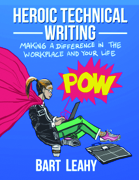 Heroic Technical Writing: Making a Difference in the Workplace and Your Life
Heroic Technical Writing: Making a Difference in the Workplace and Your Life
Bart Leahy. 2020. Heroic Technical Writing. [ISBN 978-0-578-58165-1. 210 pages. US$12.99 (digital).]
Do you want to find out what can be “heroic” about technical writing? I was curious when I read the title of Bart Leahy’s book. As it turned out, the book is based on the author’s blog by the same name (https://heroictechwriting.com/).
Readers familiar with the blog know Leahy’s foundation in the space business, with a history of working at NASA as an English major. Leahy admits, “Originally, the title of the book was “An English Major at NASA” (p. 202), but then he decided to broaden the scope to help students and young professionals, regardless of careers.
If you are an aspiring writer aiming to get an insight into the life of a technical writer in the US working in the space industry, you will get the most out of the book. By contrast, I have been working for more than 20 years as a technical writer and translator in the software industry in Europe and found some topics in the book quite exotic. For example, I was not even aware of some of the document types (i.e., replies to complaint letters or creative briefs) mentioned as deliverables of a technical writer. I had to look up Small Business Innovation Research (SBIR) proposals in the glossary.
Nevertheless, even with a completely different background and no matter where you find yourself in your technical writing journey, Heroic Technical Writing: Making a Difference in the Workplace and Your Life will provide valuable, helpful, and at the same time entertaining information and stories.
Keeping a light, personal tone, Leahy gives advice and shares honest thoughts on a wide range of topics related to technical writing. The book is separated into six major sections: Products, Process, People and Politics, Professionalism, Pursuing Work, and Protecting Yourself.
Remarkably, Leahy also openly talks about mistakes he has made during his career so that the reader does not have to make them. In Chapter 8, he explains: “Sharing my little foibles with you is partly an effort to make my writing somewhat entertaining, partly a reality check for someone who thinks X career is “perfect,” and partly used as an opportunity to show that even full-time technical writers can make mistakes and recover from them” (p.134).
While a lot of statements and musings in Heroic Technical Writing seem like common sense and would probably apply to any profession, the book is an important reminder of what working life is about and what “heroic” can mean for technical writing, namely “Be a good person.” (p. 199). What I liked most about the book is that it shows how passionate Leahy is about technical writing—and I strongly believe myself that if you are not passionate about what you do, you will not do it well.
Karina Lehrner-Mayer
Karina Lehrner-Mayer is an STC Senior member, holds a degree in translation, and has more than 20 years’ technical communication experience. She works as a Documentation Specialist at the Austrian-based headquarters of ISIS Papyrus Europe AG, an international company offering solutions for inbound and outbound business communication and process management.
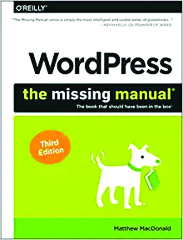 WordPress: The Missing Manual® –The Book That Should Be in the Box®, 3rd ed.
WordPress: The Missing Manual® –The Book That Should Be in the Box®, 3rd ed.
Matthew MacDonald. 2020. O’Reilly. [ISBN 978-1-492-07416-8. 480 pages, including index. US$49.99 (softcover).]
WordPress is a free software originally intended for writing blogs that has evolved to include websites and even e-commerce. While content produced with WordPress can be stored on its associated hosting service, the software can also be installed on almost any webhost’s servers.
Matthew MacDonald starts at the beginning—installing the software—then takes the reader through increasingly complex changes—including using add-on mini-programs called plug-ins—and ends with adding a shopping cart. On the way, he also covers webmaster topics such as site statistics and search engine optimization.
The book does not assume any previous web coding experience, explaining basic terms and concepts. At times that’s taken a little too far, though. For example, a paragraph that starts with “But if you have any sort of web design background” explains what HTML is (p. 164). Anybody with that kind of background will know HTML as the basic markup language for displaying content on the web.
Beyond the technical details of various features, MacDonald also discusses issues to consider when, for example, deciding on categories to which posts or pages can be assigned. Most of the book’s information relates to formatting, automating, and structuring blog posts, but the process is the same for creating websites, and MacDonald addresses differences between blogs and websites when they exist.
The first few chapters expound on why using WordPress is better than coding a website from scratch. While maintenance is easier on the blogging platform, implementing a highly customized design may be simpler using the web markup language. At least that’s my experience—I coded my translation site in HTML and run my writing site using WordPress. While reading the book, I marked several passages for implementation on my writing site. However, there is no need to convince me of the platform’s benefits—I wouldn’t have picked up the book if I didn’t think WordPress was worth a try.
As with many books these days, WordPress: The Missing Manual could benefit from more rigorous copy editing, for example, on p. 423: “. . .you’ll look a closer take at. . . ” Only once do such mistakes impede understanding: when SEO plug-ins are discussed, but it is unclear whether the two names used (Yoast SEO and WordPress SEO, p. 378 ff.) refer to two different mini-programs or are two names for the same one.
If you want to create your own blog or website, this guide will take you through the process and offer helpful tips along the way. If you want to update an existing site, the detailed table of contents will help you pick just the sections you need.
Barbara Jungwirth
Barbara Jungwirth writes about medical topics (www.bjungwirth.com) and translates medical and technical documents from German into English (www.reliable-translations.com). She has written for print and online media since her high school days and majored in media studies. You can find her on Twitter at @bjungwirthNY.
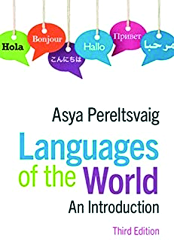 Languages of the World: An Introduction, 3rd ed.
Languages of the World: An Introduction, 3rd ed.
Asya Pereltsvaig. 2021. Cambridge University Press. [ISBN 978-1-108-74812-4. 482 pages, including index. US$39.95 (softcover).]
Asya Pereltsvaig’s third edition of Languages of the World: An Introduction succeeds admirably in structuring a curriculum for beginning linguistic students while also serving as a reference work, a guide to further research, and a book to dip into for fascinating language insights. Chapters are organized by geography and language family and move from interesting anecdotes about language to formal analysis of phonology, morphology, syntax, and grammar. The inherently technical subject is enhanced by Pereltsvaig’s enthusiastic yet professional tone and clarified by her numerous tables, charts, sidebars, study questions, and web research topics.
The book’s approach is to explore the underlying unity of the hugely diverse world languages through a process of “comparative reconstruction” that infers a common ancestral language family (pp.14–15). Languages are defined by their relative position on the “dialect continuum” (p. 9). Dialects close together on the continuum are mutually intelligible, like American and British English, and constitute a language. Dialects far apart, like Cantonese and Mandarin, are mutually unintelligible, and therefore different languages, despite sharing a common ideographic writing system (pp. 249, 252). By comparing cognates, sound correspondences, and grammar, linguists can reconstruct a common ancestral language, such as Indo-European, for languages as different as English, Hindi, and Czech. Cantonese and Mandarin, despite their mutual unintelligibility, belong to the Sino-Tibetan family, yet are unrelated to another contiguous family, Austro-Asiatic, or to Korean and Japanese, two isolates that comprise their own unique language families.
The question then arises: Is there an underlying unity between language families and isolates that posits an innate linguistic ability in humans? The question led to the development of Greenberg’s Universals and the Parametric Theory of Language, which postulate underlying structural rules, or grammars—for instance, the relationship between Subjects (S), Verbs (V), and Objects (O)—that persist across the most diverse languages. Greenberg showed that languages requiring the verb-object (VO) order are almost always prepositional, whereas object-verb (OV) languages are almost always postpositional, regardless of language family: Spanish (Indo-European) and Arabic (Semitic) use VO, Japanese (isolate), and Chechen (Northeast Caucasian), OV.
A related rule is the Headedness Parameter. The Head “determines the meaning and properties of the whole phrase” and is accompanied by the Complement, which completes the meaning of the phrase (pp. 445, 444). This parameter is binary: The Head may precede or follow the Complement but must do one or the other. If the Head comes first, the sequence is OV. If the Head comes last, the sequence is VO. Languages, though “different,” are therefore also fundamentally “commensurable” (p. 102). If they weren’t, translation would be impossible.
Using such rules and the sound inventory available to humans, linguists can construct languages like Klingon or Dothraki never heard before and without native speakers, yet commensurate with all other natural languages. Given Pereltsvaig’s thorough, intriguing account, perhaps homo sapiens should be renamed homo loquens, with language the distinguishing human characteristic.
Donald R. Riccomini
Donald R. Riccomini is an STC member and Emeritus Senior Lecturer in English at Santa Clara University, where he specialized in engineering and technical communications. He previously spent twenty-three years in high technology as a technical writer, engineer, manager, and director in semiconductors, instrumentation, and server development.
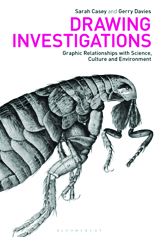 Drawing Investigations: Graphic Relationships with Science, Culture, and Environment
Drawing Investigations: Graphic Relationships with Science, Culture, and Environment
Sarah Casey and Gerry Davies. 2020. Bloomsbury Visual Arts. [ISBN 978-1-78831-026-0. 236 pages, including index. US$115.00 (hardcover).]
In an age where technology is touted as the most powerful investigative tool available to researchers, Sarah Casey and Gerry Davies argue for the age-old practice of drawing as an equally powerful investigative tool. Their book, one part of the Drawing In series, discusses drawing as an investigative and communication medium in areas of study outside the visual arts. Some of these areas include medical science, theoretical math, environment, history, culture, and conflict.
Each chapter covers a unique field of study and explores different ways drawing has been used by people from varying professional backgrounds and investigative motivations to expand their knowledge in that field. The authors choose an eclectic mix of accounts. Third-person narratives about artists from the past are paired with interview transcripts of current artists; the latter provide a more intimate understanding of the thought process behind the artists’ investigative drawings. For example, the story of a researcher studying the fluid dynamics of heart formation by capturing the movement of dye in water is juxtaposed next to the account of a woman trying to understand the nature of her degenerative disease by drawing the disfigurement of bones it causes.
To technical communicators that use and write about evolving technology, an argument for drawing might seem archaic. However, the authors present arguments for using drawing in any investigative work, which are applicable to the field of technical communication as well. For example, technical communicators need to understand a process before they can effectively write about it. The stages preceding the development of a technical document are highly investigative and extrospective, just like the process of drawing. So, as the authors point out, even though digital photography offers a high degree of objectivity and accuracy of details about a subject, its speed of production can be a disadvantage to a researcher. While drawing, the artist spends hours near his or her subject, noticing the most elusive of details and obtaining a deeper knowledge of the subject and its mechanics. This in-depth knowledge is the holy grail we seek as technical communicators to do our work.
In Drawing Investigations: Graphic Relationships with Science, Culture and Environment, Casey and Davies include numerous examples of investigative artists coupled with interesting discussions about how these artists have selected drawing techniques and tools to meet their research needs. However, I would have preferred to have had more pictures in the book to help in understanding the content better. I would suggest that readers keep a computer or cellphone handy while reading so that they can look up and enjoy more of the mentioned drawings. Otherwise, this enjoyable, thought-provoking book is a must-read for all, especially technical communicators who are looking for new avenues of learning.
Arsela Haque
Arsela Haque is an STC student member, is a science reporter, and is currently enrolled in the technical communication program at the University of Alabama in Huntsville. She holds a master’s in Chemistry and enjoyed writing blog posts for her undergraduate P-Chem class.
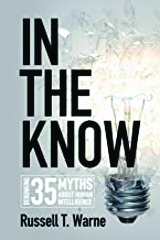 In the Know: Debunking 35 Myths About Human Intelligence
In the Know: Debunking 35 Myths About Human Intelligence
Russell T Warne. 2020. Cambridge University Press. [ISBN 978-1-108-71781-6. 418 pages, including index. US$25.99 (softcover).]
Psychologist Russell T. Warne believes that intelligence is one of the most important human traits. Intelligence research has been conducted for more than 100 years, yet there is a big gap between what the public believes about human intelligence and the facts that research has uncovered. Warne has written In the Know:Debunking 35 Myths about Human Intelligence as a “guide to correct common false beliefs” (p. xvii) because understanding the truth about human intelligence can help people realize its impact in their lives. His target audience is the non-expert in human intelligence, that is, “students, non-psychologists, K-12 teachers, interested laymen, and scientists from outside the field” (p. xv). He hopes this scholarly knowledge will trickle down from these readers to the public, including the media.
The introduction to In the Know provides a content overview as well as a history of intelligence research. The 35 chapters are divided into sections; section titles reveal hints of the important impacts of intelligence on people’s lives: The Nature of Intelligence; Measuring Intelligence; Influences on Intelligence; Intelligence and Education; Life Consequences of Intelligence; Demographic Group Differences; and Societal and Ethical Issues. Once readers have digested the introduction, they can choose chapters that interest them, each of which can stand alone, although some may refer to previous chapters.
Warne confronts each of the 35 myths chapter by chapter, starting by citing experts who have been sources of false beliefs. He refutes each, not just with his own opinion and research, but with “opinions that are widely held among intelligence researchers” (p. xvi) while giving examples of false beliefs that permeate daily life. For example, a standard psychology textbook may teach that “Measuring Intelligence Is Difficult (Myth #7).” T-shirts and tote bags proclaim that “Every Child is Gifted (Myth #18).” Jury members with average IQ may not understand that a person with a low IQ may falsely confess to a crime (“Everyone Is About as Smart as I Am – Myth #35”). Despite the amount of research that has been and is being done, “erroneous beliefs about intelligence are widespread” (p. 336). They have repercussions in hiring practices, government policies, and school admissions, among other crucial elements of everyday life. They have become ingrained in the public mind and “inhibit scientific and social progress” (p. 2).
Warne has written a readable book on a technical subject. His point of view is backed up by citations of studies throughout In the Know as well as being further explained by figures and tables. His claim to be as non-technical as possible comes with the caveat that research involves statistics. Rather than leave the statistical novice in the dark, Warne includes a statistics “crash course” in the introduction. However, crash course notwithstanding, many readers may find themselves at a disadvantage because much of In the Know does rely on this knowledge.
Linda Davis
Linda M. Davis is an independent communications practitioner in the Los Angeles area. She holds an MA in Communication Management and has specialized in strategic communication planning, publication management, writing, and editing for more than 25 years.
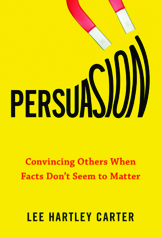 Persuasion: Convincing Others When Facts Don’t Seem to Matter
Persuasion: Convincing Others When Facts Don’t Seem to Matter
Lee Hartley Carter. 2019. TarcherPerigee. [ISBN 978-0-14-313347-6. 270 pages. US$16.00 (hardcover).]
In Persuasion: Convincing Others When Facts Don’t Seem to Matter, author Lee Hartley Carter pulls back the curtain on the inner workings of communication strategies being implemented by some of the world’s biggest brands. Carter is a language strategist and president of maslansky + partners, a communications consulting group. She argues that effective persuasive rhetoric can deliver lasting change to opinions and behaviors when guided by her company’s philosophy, “It’s not what you say, it’s what they hear” (p. 187).
The introduction addresses the eye-catching subtitle concerning the role of facts in persuasion. Carter bluntly states that, according to psychological research, facts never have been the rhetorical tool we imagined. She cites a recent article in Social Psychological and Personality Science which argues that humans are not natural fact-seekers. Instead, we tend to categorize opinions that we agree with as facts due to confirmation bias and reject challenging factual information. Carter bases her strategic approach to persuasion on this framework.
Persuasion is divided into five parts which present a method of designing and implementing persuasive rhetoric. Throughout the book, Carter emphasizes how you can apply her strategy to your personal and professional situations. Part 1: You focuses on a persuader’s initial actions and encourages practitioners to begin by articulating a specific, bold, yet attainable goal. Carter contends that “Persuasion is about finding an authentic story that will change beliefs or behaviors” (p. 37).
Part 2, Them, is about the other side of the persuasion equation, the target audience. Carter highlights the necessity of genuinely hearing and empathizing with listeners by applying an “active empathy” approach (p. 63). This approach includes seeking out the opinions of naysayers or those who have no strong opinions about our vision. Persuasion based on “fostering connectivity” is more likely to produce positive change in viewpoints (p. 86).
Part 3, Connection, outlines the basic features of an effective persuasion plan. Carter advises persuaders to use feedback from their audience to construct three central tenets of their persuasive message. These components form a master narrative, which is the language that becomes the “singularly focused message that defines and differentiates you” (p. 110). In Part 4, Story, Carter advises that the strongest narratives are conveyed through visual language and stories. Since “memorability is one of the keys to persuasion,” anecdotes, images, and symbolic gestures are critical features of effective persuasion (p. 170). Part 5, Ownership, urges persuaders to test their persuasion plan and adjust it based on unbiased feedback.
At first glance Persuasion appears to be written for corporate marketing strategists. Carter shares success stories and cautionary tales from industry to illustrate her points. However, her formulaic approach to constructing a persuasion plan is generalizable to nearly any situation. Carter’s broader points about relying on empathy and listening as the basis for building a persuasive strategy are also universally applicable in persuasive writing.
Rachel Wyatt
Rachel Wyatt is working towards her graduate certificate in technical communication from the University of Alabama in Huntsville. She writes and edits curriculum and assessments for Southwestern Advantage.
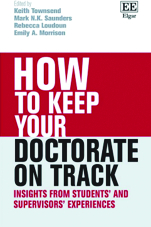 How to Keep Your Doctorate on Track: Insights from Students’ and Supervisors’ Experiences
How to Keep Your Doctorate on Track: Insights from Students’ and Supervisors’ Experiences
Keith Townsend, Mark N.K. Saunders, Rebecca Loudoun, and Emily A. Morrison, eds. 2020. Edward Elgar Publishing. [ISBN 978-1-80037-530-7. 448 pages, including index. US$55.00 (softcover).]
Navigating doctoral work is challenging in many ways. Given that struggles are commonplace, anyone pursuing graduate work should have plenty of support and at least one practical guide, like How to Keep Your Doctorate On Track.
Editors from three nations collected chapters and vignettes from 59 contributors spanning the globe. Each author (from current doctoral students to recent graduates to current supervisors) writes practical advice on managing doctoral work, regardless of which university in which country on which continent the student works. The text sometimes reads like an instructional guide, providing advice or warnings, and sometimes like a conversational seminar where each student tells their story of a problem and solution to graduate work. The book has been well edited so that the text is pleasantly readable throughout, whether the subject is managing stress or the light-hearted chapter of letters to a data collection advice column.
Organized into three parts, the topics range from logistics (determining a research topic, receiving feedback, analyzing qualitative data, and getting Institutional Review Board (IRB) approval) to interpersonal skills (managing time, dealing with stress, handling or changing supervisors, combating impostor syndrome). Longer chapters contain research and references, while most vignettes capture personal narratives. The book is meant to be sampled, read out of order, and dipped into throughout the doctoral process—whether for a PhD, EdD, DBA, or another doctorate.
While the contributing authors of How to Keep Your Doctorate On Track work mostly in the fields of business or the social sciences, they did an excellent job of writing about experiences that apply broadly. Engineering students won’t find information on data analysis and visualization, for example, but they will find topics on thinking about research and designing quantitative research.
Perhaps the biggest hurdle for most doctoral students is writing, from proposals to journal articles to the dissertation, so it’s no surprise this book gives so much attention to writing: process, planning, revision, reviewing, and publishing. There’s a chapter on the literature review. And for the second largest hurdle, there’s a chapter on the oral defense.
While the primary audience is obviously those considering or undertaking doctoral work, one key secondary audience is supervisors themselves. Each section pairs the perspectives of supervisors/professors with those of students. As the editors themselves point out, the student perspectives can be eye-opening. Perhaps if more supervisors paused to reflect on the varied experiences presented in this text, they could help mitigate some of the anxiety and depression felt by students under their tutelage.
The eBook version is priced from UK£22/US$31 from Google Play, ebooks.com, and other eBook vendors, while in print, the book can be ordered from the Edward Elgar Publishing website.
Kelly A. Harrison
Kelly A. Harrison, MFA, teaches technical communication at Stanford University. Formerly, she taught a range of writing courses at San José State University and wrote for various high-tech companies. Kelly is the Associate Editor for West Trade Review.
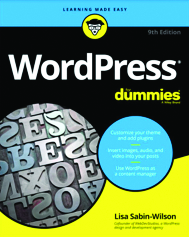 WordPress for Dummies. 9th ed.,
WordPress for Dummies. 9th ed.,
Lisa Sabin-Wilson. 2021. John Wiley & Sons, Inc. [ISBN 978-1-119-69697-1. 462 pages, including index. US$29.99 (softcover).]
When I first heard the buzz that WordPress was becoming widely used for more than just blogging software, I ignored it. Digital immigrants like me have witnessed the rise and fall of several different content management systems (CMSs), from FrontPage to Dreamweaver. Why bother learning a new CMS when everyone knows the gold standard is still code? After all, in a few years even the newest program will become obsolete. Right? Wrong! Fortunately for those who would rather focus more on content than code, WordPress has proven to have extraordinary staying power, powering 35% of the web pages online today (p.1). WordPress for Dummies, 9th ed., by Lisa Sabin-Wilson is an entertaining, easily digestible way to learn how to use this program.
This edition focuses on the more robust WordPress self-hosting software available for download on WordPress.org rather than the hosted version available on WordPress.com. The self-hosted software offers many features that are not available on the more familiar WordPress.com site, such as access to the core code and free access to templates and plug-ins (p. 13). This software is the preferred choice for professional websites, and according to Sabin-Wilson is the software underpinning sites such as the BBC America website and the Boise State University website (p. 14).
Like all the books in the “For Dummies” series, WordPress for Dummies is easy to navigate and beautifully designed. Sabin-Wilson’s book contains helpful icons to draw the reader’s attention to important information, callouts containing instructions and troubleshooting information, and references to helpful sites, and examples that illustrate the process of installing and using the WordPress software. The text is comprehensive and contains all the information a reader would need to know to set up a website, including choosing a hosting site, applying and tweaking a WordPress theme, and installing plug-ins for their site.
This text does have some minor drawbacks. At times it reads more like a sales tool for WordPress than an objective guide to the program. You won’t find information about bugs common to the WordPress software here or in-depth comparisons to any other similar software programs. Similarly, WordPress for Dummies does not contain any information about making effective design choices for your site when perusing the thousands of templates available, nor does it explain what you can do with the code behind the scenes. Readers new to web design will need to purchase supplemental materials on effective design and writing for the web.
I would recommend WordPress for Dummies for readers who have made the decision to use WordPress to design their professional website or blog, especially those looking to move beyond the simple hosted programs available at WordPress.com or other similar websites.
Nicole St. Germaine
Nicole St. Germaine is a Professor in the Technical and Business Writing Program at Angelo State University, as well as a freelance writer and consultant. Her research interests include technical communication for a Mexican-American audience and technical communication in the health fields.
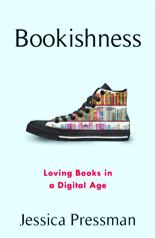 Bookishness: Loving Books in a Digital Age
Bookishness: Loving Books in a Digital Age
Jessica Pressman. 2020. Columbia University Press. [ISBN 978-0-231-19513-3. 196 pages, including index. US$30.00 (softcover).]
In Bookishness: Loving Books in a Digital Age, Jessica Pressman situates the love of books as physical objects in the context of the digital world that threatens to render physical books obsolete. Pressman describes “bookishness” as follows: “creative acts that engage the physicality of the book within a digital culture, in modes that may be sentimental, fetishistic, radical” (p. 1). These modes manifest in myriad ways, from “kitschy” leggings with the words of Pride and Prejudice printed on them and books being cut up and shaped to create new visual art to literary and popular works of fiction that examine the physical book as an important artifact in our digitally mediated world. Overall, Pressman skillfully illuminates a contemporary phenomenon so ingrained into our cultural relationship with the physical book that its presence will likely seem unmistakable after reading the text. While the book uses some technical language from literary studies, Bookishness will likely be accessible to technical communicators interested in this topic.
The book is comprised of six main chapters with additional “Introduction” and “Coda” sections that help contextualize and cohere the overarching arguments present in the text. Chapter 1: How and Now Bookishness “situates bookishness historically” and explains how the anxieties surrounding the death of the book at the turn of the 20th century helped to create bookishness (p. 21). Chapter 2: Shelter discusses contemporary fiction that shares the idea that books provide a haven from some of the horrors that have accompanied the advent of the digital world, such as 9/11. Chapter 3: Thing examines diverging narrative works that show “the book as a thing, a poignant artifact and fetish object for the digital age” (p. 22). Chapter 4: Fake elaborates on how the idea of “fakery” (such as the presentation of books on shelves in digital spaces) is essential to digital culture and how this fakery extends to bookish culture. Chapter 5: Weapon and Chapter 6: Memorial provide close readings of contemporary works of fiction that show, respectively, how the “materiality” of the book has been used to attack “monstrous” digital forms and how bookishness works to memorialize not only past people and books but our passing, contemporary bookish moment.
Bookishness will likely be of interest to technical communicators interested in literature and books broadly, and those concerned with how physical and digital mediums interact in our contemporary world.
Dylan Schrader
Dylan Schrader is a proposal developer at the University of Alabama in Huntsville, where he also earned an MA in Professional Communication.
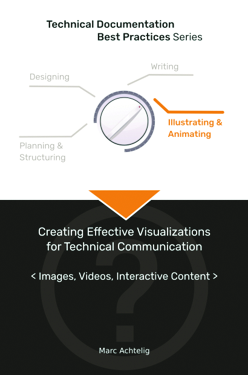 Creating Effective Visualizations for Technical Communication <Images, Videos, Interactive Content>
Creating Effective Visualizations for Technical Communication <Images, Videos, Interactive Content>
Marc Achtelig. 2020. indoition publishing e.K. [ISBN 978-3-943860-10-8. 340 pages. US$49.00 (softcover).]
The long-awaited fourth book in Marc Achtelig’s Technical Documentation Best Practices series was finally published at the end of 2020. The first three books in the series on planning and structuring, designing, and writing have been around for a long time, being my favorite go-to references in my daily work. Creating Effective Visualizations for Technical Communication now completes the series.
When the new book in the series became available, I had to get it as I was looking for advice on a specific question: In a team where we must handle an incredibly high number of screenshots, we often discussed the idea of getting rid of figure captions, without reaching a decision. While many industry guidelines talk about style, tone, capitalization, and other details, few recommendations exist about handling screenshots in software documentation. Would I find an answer to our question in the new book?
Like the other books of the Technical Documentation Best Practices series, Achtelig’s book is full of practical advice and numerous examples. “The book provides clear rules and unambiguous recommendations. No boring theory, no musings, no shoptalk.” (p. 9) You don’t have to read the book from start to finish, but you can go to any chapter you wish because all topics are independent of each other. Teaching the principles of effective visualization, the book covers general recommendations for visuals like “Common basics of visualization” and “Images in general.”
You find information about images of hardware and software (including chapters such as “Get rid of dead space”), including chapters on video design and production as well as on interactive content. One of the chapters gave me the information I needed: “You rarely need figure titles” supported our decision to let go of figure captions for graphics in our technical documentation.
Achtelig is a technical documentation expert based in Europe, offering consultancy in software user assistance with his company, indoition. All books in the series are also available in German, giving examples and terminology for writers working in German. He offers all four books of the Best Practice series in a bundle, sold as the Technical Writer’s Companion as an electronic guide and reference for technical writers.
I love the Technical Documentation Best Practices series because of its no-nonsense tone, practical tips, and real-life examples. For a technical writer working in software documentation, Creating Effective Visualizations for Technical Communication is such a valuable reference in a time where visuals like screenshots, diagrams, and videos play an ever-increasing role.
Karina Lehrner-Mayer
Karina Lehrner-Mayer is a Senior STC member, holds a degree in translation, and has 20 years’ experience in Technical Communication. She works as a Documentation Specialist at the Austrian-based headquarters of ISIS Papyrus Europe AG, an international company offering solutions for inbound and outbound business communication and process management.
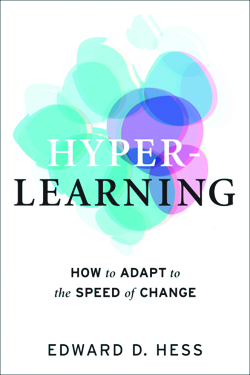 Hyper-Learning: How to Adapt to the Speed of Change
Hyper-Learning: How to Adapt to the Speed of Change
Edward D. Hess. 2020. Berrett-Koehler Publishers, Inc. [ISBN 978-1-5230-8924-6. 320 pages, including index. US$29.95 (hardcover).]
“Hyper-Learning is continual learning, unlearning, and relearning” (p. 1). It is “learning that is over and above what is typical” (p. 2). While many of us might take “hyper” to mean overly excited or unusually energetic, the theme in Hyper-Learning: How to Adapt to the Speed of Change is finding inner peace through a quiet ego, a quiet mind, a quiet body, and a positive emotional state.
Edward Hess defines inner peace as quietness and stillness that enables you to be fully present “with an open and non-judgmental mind and lack of self-absorption. It’s a state of positivity with limited stress and fear” (p. 23). For example, if you are in a room full of people sharing ideas, inner peace will help you to recognize and embrace new opportunities, manage your emotions when things get intense, and engage your brain, mind, and body for Hyper-Learning.
In Chapter 2, you will learn how to adopt a Hyper-Learning mindset, which may challenge deeply ingrained attitudes you have about how you learn, manage your thoughts and emotions, and relate to others. While reading, you will have opportunities to reflect on various topics and take diagnostic tests to assess your current mindset and where you stand on this growth journey.
By Chapter 10, you will be asking yourself if you can adapt and evolve to stay relevant and flourish in the digital age and if your Hyper-Learning mindset will help you add value to society in ways that technology can’t. If you want to answer in the affirmative, read Hyper-Learning (and re-read as necessary) and take the time to reflect on the questions and situations presented throughout the book.
For inspiration, there are two “personal transformation” stories in Chapters 4 and 5 that tell how each person pursued a new way of being and a new way of working on their way to a Hyper-Learning mindset. They share the approaches they took, attitudes they had to work on, and their “why, what, and how.” For example, one person uses centering and meditation to quell unproductive mental chatter and has since learned that her staff members appreciate centering breaks when meetings get heated. The other had a pivotal moment when he realized only like-minded people were in his social circle. Once he sought out people who were different than him, he discovered a new fullness in life.
How will you get comfortable with the new, the different, and the unknown? “A mindset that is comfortable with impermanence enables you to be curious about the answers” (p. 261). Curious people will thrive in the age of digital advances. Let this book get you started on the path to learning and growing in your personal life and in your work life while developing a Hyper-Learning mindset.
Michelle Gardner
Michelle Gardner, CPTC, is the marketing content writer for a life sciences company and the editor-in-chief for the Mi MoJo Methods Web site. She has a bachelor’s degree in Journalism: Public Relations from California State University, Long Beach, and a master’s degree in Computer Resources and Information Management from Webster University.


